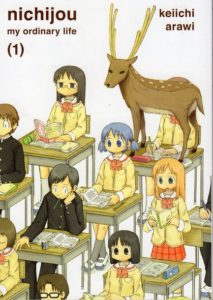Manga Review: Nichijou: My Ordinary Life (1) by Keiichi Arawa
The ordinary lives that all of us lead every day might perhaps be a succession of miracles.
This is the story of four ordinary high school girls living their ordinary everyday lives. Yukko, cheerful but not very bright; Mio, who’s of average intellect and has an artistic streak; the quiet and book-smart Mai; and Nano, who’s a robot with a wind-up key in her back. They all have their little quirks, and strange things happen often, but it’s all a part of ordinary life.
Nichijou (“Everyday”) is a shounen (boy’s) comedy manga that ran from 2006-2015, with an anime adaptation in 2011. There isn’t much of a narrative arc; most of the stories depict short scenes from the lives of one or more characters’ daily lives…strange as those events may be. There are some recurring themes, the most frequent of which is Nano’s desire to blend in with humans, and her frustration with her inventor/ward, eight year old mad scientist Professor Shinonome, who refuses to remove the key in her back.
In this first volume, we are introduced to the main characters as they head to school in the morning (Nano doesn’t quite make it.) Yukko tries to figure out why Mai is ignoring her. Nano has difficulties with new functions the Professor installed in her body. The pretentious Sasahara (drama club president) and hot-tempered Misato (kendo club member) try to decide what to do for the cultural festival.
There’s a school assembly led by Principal Shinonome (who may or may not be related), known for his “dad jokes” and the intensely shy Ms. Sakurai. Yukko witnesses a wrestling match between the principal and a deer–and can never tell anyone. Yukko and Mai play rock-paper-scissors. Yukko and Mio build a card house (this is a silent chapter.) Yukko fails to study for finals, and the questions seem indecipherable.
Yukko tries to finish her lunch despite dropping a key ingredient. Nano and the Professor have cake. Ms. Sakurai tries to enforce school rules on Sasahara. Mio belatedly remembers she drew an embarrassing picture in her notebook when Yukko tries to borrow it. Mio gets a part-time job that sucks. Yukko finally did her homework on time, but didn’t remember to bring it back to school. Nano suffers from over the top comedic reactions due to the Professor’s latest modifications.
The short pieces are usually funny, though some of them rely on Japanese conventions of comedy that might be opaque to newer readers of manga. The lack of focus and chapters where nothing much happens might also make this less appealing to some readers. Also, there’s some slapstick violence.
I especially like the card house chapter, which utilizes suspense and the previously established characterization to build to a silly conclusion.
The art in this first volume is less than stellar, and suffers greatly from “same face”–the artist improved greatly over the course of the series.
A word or two more about the anime: It does not present the sketches in the same order, allowing it to have a plot arc where Nano has to convince the Professor to let her attend school. It also has interspersed gags from the creator’s other series Helvetica Standard, and in the second half of the season, the closing credits feature a different song each time.
I recommend this series for fans of sketch comedy and magical realism.
And now, a music video based on scenes from the anime:

